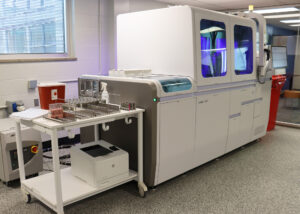Documentation, Early FDA Engagement, and Understanding of Regulations All Critical
Based on our observations, approximately 75 percent of the market has experienced a lack of clarity about regulatory requirements or FDA expectations for study designs. Our expertise in working with the FDA can help ensure clarity in study design and navigate associated regulatory challenges.
The design and development process for IVDs typically involves the preparation of key planning documents such as the Design and Development Plan, Regulatory Plan, Risk Management Plan, and Verification and Validation Plan. The draft documents that are created early on should be revisited throughout the development process, adding details, especially as the design of the device evolves and feedback is received from a regulatory agency such as the FDA. For example, a Regulatory Plan may need to be updated following an FDA pre-submission meeting in which study designs, device requirements, and regulatory pathway are discussed.
To Include in the Regulatory Plan
There are several important elements to include in the regulatory plan, many of which should be updated as the FDA is engaged.
- Purpose
- Scope
- References list – Include regulatory guidance documents, standards, publications and project documents (e.g., clinical validation, design verification, and analytical validation plans)
- Product Information (device description)
- Proposed Intended Use
- Regulatory Strategy Summary – Request the FDA’s feedback and update your strategy accordingly.
- Regulatory Classification Information
- Proposed Regulatory Path – Engage the FDA early in the process and update this path as feedback is received.
- Predicate Comparison Table
- IDE (Investigational Device Exemption) Considerations
- Tracker for FDA Interactions – Note your FDA interactions in a table including feedback.
- Table of Premarket Submission Deliverables and Responsible Parties
- Analytical and Clinical Requirements List – Request feedback from FDA early on these requirements and plan accordingly.
- Labeling Description
- Table of Regulatory Correspondence – Include subject, date, and specific feedback that is part of the specific device Q-submission (pre-sub) number; these are important to reference during future FDA communications.
- Abbreviations List
Pathways to Market Entry
There are multiple ways that IVDs can enter the U.S. market. If looking for resources from the FDA, one of the best places to start is the Center for Devices and Radiological Health (CDRH) website. They oversee device regulation for IVDs. Assays that include a SARS-CoV-2 target can potentially go through an Emergency Use Authorization (EUA) pathway. Otherwise, IVDs often go through a 510(k) premarket notification or premarket approval (PMA) pathway. High-risk devices generally go through a PMA pathway for market approval, while a De Novo pathway is often for low-to-moderate risk devices that don’t have a predicate. The pathway is determined in part by the risk classification and whether a predicate device can be identified.
A predicate, of course, is an existing legally marketed device with the same intended use and technological characteristics. Notably, there is some room for interpretation on what “same” is, which makes it important to get FDA feedback early in the process. Most IVDs for respiratory viruses will follow the 510(k) process to clearance. If there is not a predicate device, one option is the De Novo classification request pathway, which involves FDA assigning a classification to a new device and creating a new classification regulation. Once the device has this new classification regulation, it can then serve as a predicate for downstream 510(k) submissions for similar devices.
The device classification and existence of a predicate will shape the regulatory pathway, the types of regulatory controls that will be needed, and the data that the FDA will look for as part of the medical device submission. One of the best ways to initiate the process of developing the regulatory strategy and gathering information is through a pre-submission to the FDA. To get the most out of an FDA “pre-sub”, it is best to have the device’s intended use and sufficient information about the device design for the Agency to advise on protocols and test methods.
After receiving feedback from the FDA, be sure to reconcile their outstanding questions. If there is alignment, additional clarification as a supplement to the pre-sub may be necessary, though submitting a 510(k) or De Novo classification request directly is also an option.




